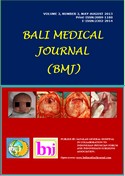HIGH ARTERIAL BLOOD LACTATE AS SIRS PREDICTOR IN PATIENTS WITH SEVERE HEAD INJURY
Abstract
Objectives: Lactate is one of the prognostic factor for evaluation of clinical severe head injury patients outcome. Lactate is also known as a factor to support diagnostic and prognosis of SIRS cases. Severe head injury is a head traumatic case frequently found in Emergency Units, where some cases result in mortality. Based on Glasgow Coma Scale (GCS), severe head injury is define as a head injury with GCS score between 3 and 8. This study aims to determine whether high arterial blood lactate can be used as predictor that causes the occurrence of SIRS. Method. A Cohort prospective study applied in this research to determine arterial blood lactate as a predictor that causes the occurrence of SIRS. This study was conducted at Sanglah General Hospital Bali-Indonesia from May 2013 to July 2013 with 40 patients who fulfilled the inclusive criteria. Data were presented in tables and analyzed by applying Chi Square Test with CI 95% and p <0.05 was considered significant. Results: From 40 samples, 27 were male (62.5%) and 17 female (37.5%) at the age of 0-10, 2 people (5%), 10-20 years 7 people (17.5%), 20-40 years 14 people (35%), 40-60 years 12 people (30%) and over 60 years 5 people (12.5%). On the first day, patients with normal level blood arterial lactate 2 (5%), and high 38 (95%) causing SIRS (+) 39 (97.5%) and SIRS (-) 1 (2.5%) samples to occur. Using bivariate analysis between arterial blood lactate level and the amount occurrence of SIRS, we obtain p < 0.05 and variable control using multivariate analysis we obtained variable of liver dysfunction that give significant value with level arterial blood lactate with p < 0.05). Conclusion: From 40 samples of Severe head injury, there were 38 (95%) whose blood arterial lactate level increased on the first day, 2 (5%) in normal limit and 39 (97.5%) with SIRS on the third day when p < 0.05) so that high level arterial blood lactate can be used as predictor that causes SIRS to occur.


